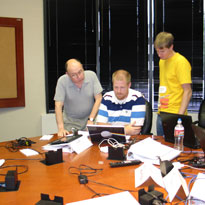SS7/C7 Overview
- Course:SS7/C7 Overview
- Course ID:SS7C7-O Duration:2 days Where: Your Office (7+ Persons)
- Download Course Description (PDF)
Available as a private, customized course for your group at your offices or ours and in some cases as a WebLive(TM) class.
Course Outline
- Session 1: Signaling Overview
- History of Telecommunications Signaling
- Network Signaling Evolution
- What is Signaling?
- What is Out-of-Band Signaling?
- A Summary of the Signaling Network Architecture
- Network Signaling Evolution
- The North American Signaling Architecture
- Signaling System No 7
- Overview of SS7, IN, AIN, Wireless, and VoIP
- Standards Organizations
- Session 2: SS7 Network Architecture
- Service Switching Points (SSPs)
- Signal Transfer Points (STPs
- Service Control Points (SCPs)
- Intelligent Peripherals (IPs)
- Service Nodes (SNs)
- Service Management and Creation
- Session 3: SS7 Signal Data Links
- Access Link (A)
- Bridge Link (B)
- Cross Link (C)
- Diagonal Link (D)
- Extended Link (E)
- Fully Associated Link (F)
- Session 4: SS7 Applications
- Advanced Intelligent Networks (AIN)
- Basic Call Setup Example
- Database Query Example
- Layers of the SS7 Protocol
- What Goes over the Signaling Link?
- Addressing in the SS7 Network
- Signal Unit Structure
- What Are the Functions of the Different Signaling Units?
- Message Signal Unit Structure
- Local Number Portability (LNP)
- SS7 and Database Connection
- Wireless Applications
- OSS Interconnection: E911/911, LIDB, OS/DA
- Session 5: SS7 Layers
- Physical Layer
- Message Transfer Part (MTP) – Level 2
- Message Transfer Part (MTP) – Level 3
- Signaling Connection Control Part (SCCP)
- ISDN User Part (ISUP)
- Transaction Capabilities Application Part (TCAP)
- Operations, Maintenance, and Administration Part (OMAP)
- Session 6: Network Service Part (NSP) of SS7
- Message Transfer Part (MTP)
- Data Link Level Signaling
- SS7 Signaling Units
- Signaling Network Function Level
- Signaling Information
- SS7 Signaling Message Types
- SS7 Network Node Identification
- SS7 Network Management Message Types
- Link and Route Management
- Traffic Management
- Signaling Connection Control Part (SCCP)
- Routing and Discrimination
- Global Title Routing
- Subsystem Management
- Session 7: Signaling Connection Control Part (SCCP)
- Enhancements to MTP Routing
- Flow Control
- Connection-Oriented and Connectionless Services
- Global Title Translation
- SCCP Management
- SCCP Management Structure
- Message Types
- Task of SCCP Messages
- Parameters of SCCP Messages
- The Principle of a SCCP Connection
- Session 8: Wireless Network Overview
- Elements in a Mobile Network
- Mobile Switching Center (MSC)
- Base Station Controller (BSC)
- Base Transceiver Station (BTS)
- Home Location Register (HLR)
- Visitor Location Register (VLR)
- Short Message Service Center (SMSC) ANSI-41 and Mobile Application Part (MAP)
- GSM, CDMA and SS7
Course in a Nutshell
Signaling System No. 7 is commonly known in North America as SS7 and elsewhere throughout the world as C7. SS7/C7 is a system used to implement signaling and protocols for telecommunications networks. SS7 supports both fixed-line and cellular networks. In recent years, expanded telecommunications services have resulted in the introduction of additional SS7 protocols and functionality.
The course introduces the basic concepts on the first day. The more complex features of SS7 level 4 protocols are covered on day two following a thorough coverage of the underlying material on SS7 levels 1, 2, and 3.
In this course, you will learn the history of signaling and the progression of the technology through both in-band signaling and out-of-band signaling protocols. The course explains the fundamental differences between the SS7 ITU-T and ANSI standards as well as the connection and connectionless signaling services. You will discover how SS7 supports cellular services such as subscriber roaming and packet-switched data services.
The course begins with several topics which explain the purpose of lower level signaling protocols MTP1, 2, and 3 including error control and network performance monitoring. The course concludes with an introduction to the upper level SS7 protocols and services.
Customize It!
Customize this course to your specific needs at little-to-no additional cost. We offer distinct versions tailored for:
- Network design and optimization engineers and technicians
- Equipment or application designers
- Less technical audiences such as managers, executives, business planners, sales and marketing specialists, and operations and support personnel
We can also tailor the course to cover particular applications or aspects of the SS7/C7 technology.
Learn How To
- Troubleshoot SS7 network problems.
- Monitor and evaluate SS7 network performance.
- Plan the integration and testing of new SS7 applications.
- Assist in the design of new mobile network applications and services.
Aimed At
This introduction to SS7/C7 is aimed at the following audiences:
- Telecommunications technicians and network maintenance personnel
- Sales and marketing professionals involved with digital switching equipment and software applications supporting SS7/C7
- Telecommunications management and support staff who wish to obtain a through understating of the SS7/C7 system as well as the latest on SS7/C7 standards, technology, and product development
Prerequisites
Those intending to take this course should have some prior basic understanding of telephony and packet switched networks.
- "Great overview of SS7, excellent knowledge, excellent speaker, kept it moving." – Engineer, United States Air Force

